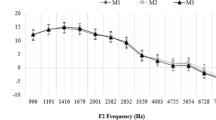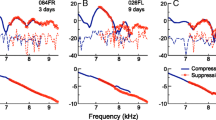Abstract
Otoacoustic emissions (OAE) and pure tone audiogram (PTA) were examined in 26 ears of 25 patients suffering from sudden hearing loss from the 1st day to up to 505 days following the drop of hearing to test the hypothesis whether the OAEs are capable of delivering predictive information about the recovery process. The patients were selected from 50 candidates according to the following criteria: one or both ears exhibited a systematic and significant recovery of pure tone threshold in at least one frequency, OAEs were detectable and PTA available, a conductive hearing loss was excluded, and the auditory brainstem responses (ABR) yielded no signs of retrocochlear disorders. Transitory evoked otoacoustic emissions (TEOAE) and distortion product otoacoustic emissions (DPOAE) were measured under constant stimulus and recording conditions in three to nine sessions. The relation between OAE level and actual pure tone threshold was subject to a regression analysis. The correlation between both parameters is small but significant. Even smaller correlations are observed if the OAE level is related to former hearing loss, whereas the correlation improves if the OAE level is compared to the pure tone threshold measured in a later session. The slopes of individual trajectories that connect the successive results of one ear in a plane defined by hearing loss and OAE level show a remarkable accumulation around zero, i.e., in many cases the OAEs remain unchanged even if the hearing loss decreases. The comparison of the OAE levels measured at an early stage with later audiograms shows that there are only a small number of cases with small initial emissions and good final threshold or large initial emissions and bad final threshold. This means that small initial OAEs end up with a remaining final hearing deficit, whereas a high OAE level immediately after drop of threshold correlates with good outcome. The reliability of an individual prediction based on the OAE level combined with the threshold after sudden hearing loss and the consequences for the physiologic mechanisms underlying the sudden hearing loss remain to be proved in further investigations.







Similar content being viewed by others
References
Boege P, Janssen T (2002) Pure tone threshold estimation from extrapolated distortion product otoacoustic emission I/O-functions in normal and cochlear hearing loss ears. J Acoust Soc Am 111:1810–1818
Bonfils P, Bertrand Y, Uziel A (1988) Evoked otoacoustic emissions: Normative data and presbycusis. Audiology 27:27–35
Bonfils P, Uziel A (1989) Clinical applications of evoked acoustic emissions: Results in normally hearing and hearing-impaired subjects. Ann Otol Rhinol Laryngol 98:326–331
Brown AM, McDowell B, Forge A (1989) Acoustic distortion products can be used to monitor the effects of chronic gentamicin treatment. Hear Res 42:143–156
Brownell WE (1990) Outer hair cell electromotility and otoacoustic emissions. Ear Hear 11:82–92
Collet L, Gartner M, Moulin A, Kauffmann I, Disant F, Morgon A (1989) Evoked otoacoustic emissions and sensorineural hearing loss. Arch Otolaryngol Head Neck Surg 115:1060–1062
Dorn PA, Piskorski P, Keefe DH, Neely ST, Gorga MP (1998) On the existence of an age/threshold/frequency interaction in distortion product otoacoustic emissions. J Acoust Soc Am 104:964–971
Fraenkel R, Freeman S, Sohmer H (2001) The effect of various durations of noise exposure on auditory brainstem response, distortion product otoacoustic emissions and transient evoked otoacoustic emissions in rats. Audiol Neurootol 6:40–49
Frolenkov GI, Belyantseva IA, Kurc M, Mastroianni MA, Kachar B (1998) Cochlear outer hair cell electromotility can provide force for both low and high intensity distortion product otoacoustic emissions. Hear Res 126:67–74
Gaskill SA, Brown AM (1990) The behavior of the acoustic distortion product 2f1-f2 from the human ear and its relation to auditory sensitivity. J Acoust Soc Am 88:821–839
Hofstetter P, Ding D, Powers N, Salvi RJ (1997) Quantitative relationship of carboplatin dose to magnitude of inner and outer hair cell loss and the reduction in distortion product otoacoustic emission amplitude in chinchillas. Hear Res 112:199–215
Hoth S (1996) Der Einfluß von Innenohrhörstörungen auf verzögerte otoakustische Emissionen (TEOAE) und Distorsionsprodukte (DPOAE). Laryngol Rhinol Otol 75:709–718
Hoth S (2001) Objektivierung von Behandlungserfolgen in der Hörsturztherapie. Anwendung der otoakustischen Emissionen. HNO aktuell 9:281––87
Kemp DT, Bray P, Alexander L, Brown AM (1986) Acoustic emission cochleography—practical aspects. Scand Audiol [Suppl] 25:71–95
Kimberley BP, Hernadi I, Lee AM, Brown DK (1994) Predicting pure tone thresholds in normal and hearing impaired ear with distortion product emission and age. Ear Hear 15:199–209
Kollar A, De Min N, Mathis A, Arnold W (1991) Einfluß einer kurzfristigen Schallbelastung auf das Verhalten transitorisch evozierter otoakustischer Emissionen. Otorhinolaryngol Nova 1:56–61
Lonsbury-Martin BL, Cutler WM, Martin GK (1991) Evidence for the influence of aging on distortion-product otoacoustic emissions in humans. J Acoust Soc Am 89:1749–1759
Lucertini M, Moleti A, Sisto R (2002) On the detection of early cochlear damage by otoacoustic emission analysis. J Acoust Soc Am 111:972–978
Martin GK, Ohlms LA, Franklin DJ, Harris FP, Lonsbury-Martin BL (1990) Distortion product emissions in humans III. Influence of sensorineural hearing loss. Ann Otol Laryngol 99:30–42
Nakamura M, Yamasoba T, Kaga K (1997) Changes in otoacoustic emissions in patients with idiopathic sudden deafness. Audiology 36:121–135
Pienkowski M, Kunov H (2001) Suppression of distortion product otoacoustic eimssions and hearing threshold. J Acoust Soc Am 109:1496–1502
Plinkert PK, Kröber S (1991) Früherkennung einer Cisplatin-Ototoxizität durch evozierte otoakustische Emissionen. Laryngol Rhinol Otol 70:457–462
Trautwein P, Hofstetter P, Wang J, Salvi R, Nostrant A (1996) Selective inner hair cell loss does not alter distortion product otoacoustic emissions. Hear Res 96:71–82
Wagner W, Plinkert PK (1999) The relationship between auditory threshold and evoked otoacoustic emissions. Eur Arch Otorhinolaryngol 256:177–188
Author information
Authors and Affiliations
Corresponding author
Rights and permissions
About this article
Cite this article
Hoth, S. On a possible prognostic value of otoacoustic emissions: a study on patients with sudden hearing loss. Eur Arch Otorhinolaryngol 262, 217–224 (2005). https://doi.org/10.1007/s00405-004-0797-x
Received:
Accepted:
Published:
Issue Date:
DOI: https://doi.org/10.1007/s00405-004-0797-x




